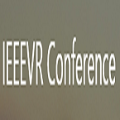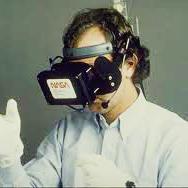Many researchers have developed VR systems for people with visual impairments by using various audio feedback techniques. However, there has been much less study of collaborative VR systems in which people with visual impairments and people with able-body can participate together. Therefore, we developed a VR showdown game which is similar to a real Showdown game in which two players can play together in the same virtual environment. We incorporate auditory distance perception using the HRTF (Head Related Transform Function) based on a spatial position in VR. We developed two modes in the showdown game. One is the PVA (Player vs. Agent) mode in which people with visual impairments can play alone and the PVP (Player vs. Player) mode in which people with visual impairments can play with another player in the network environment. We conducted our user studies by comparing the performances of people with visual impairments and people with able-body. The user study results show that people with visual impairments won 67.6% of the games when competing against people with able-body. This paper reports an example of a collaborative VR system for people with visual impairments and also design guideline for developing VR systems for people with visual impairments.
翻译:许多研究人员利用各种音频反馈技术为视力障碍者开发了VR系统。然而,对视觉障碍者和身体健全者可以共同参与的协作 VR 系统的研究要少得多。 因此, 我们开发了一个VR 显示击球游戏, 类似于真正的Showdown 游戏, 两个玩家可以在同一虚拟环境中一起玩。 我们使用 VR 的空间位置, 将听觉距离感知纳入 HRTF (首席相关变换功能) 。 我们在竞技游戏中开发了两种模式。 一种是视觉障碍者可以单独玩的 PVA (Play 与代理) 模式, 另一种是视觉障碍者可以单独玩的 PVP (Play 与玩家) 模式, 视觉障碍者可以在网络环境中和另一个玩的玩家玩。 我们进行了用户研究, 比较视觉障碍者和体健壮的人的表现。 用户研究结果显示, 视觉障碍者在与体健壮的人竞争时赢得了67.6%的游戏。 这份论文报告了一个VR 合作VR 系统为视觉障碍者设计障碍者设计VR 的视觉障碍者设计指南的例子。













